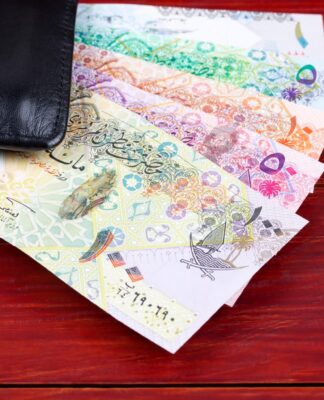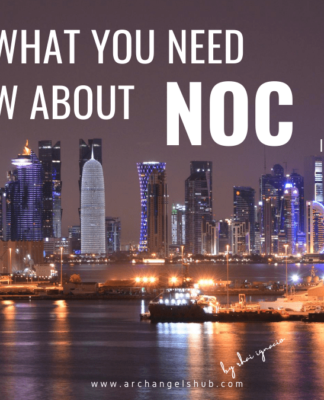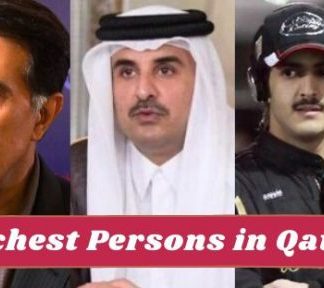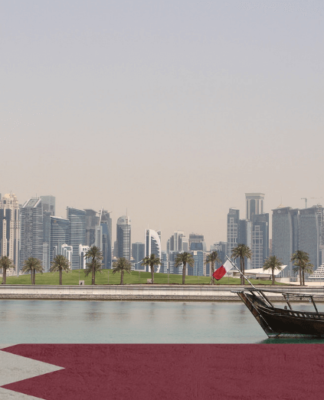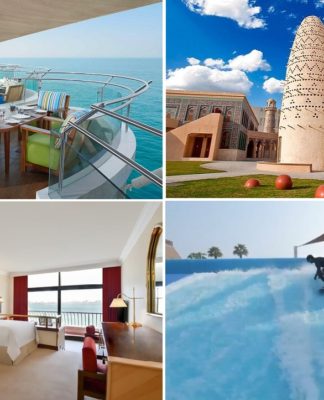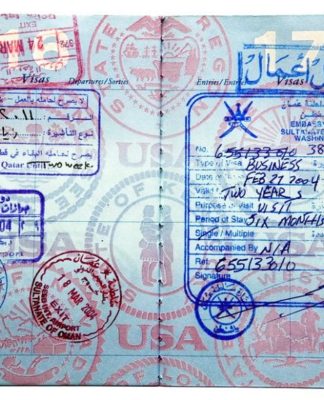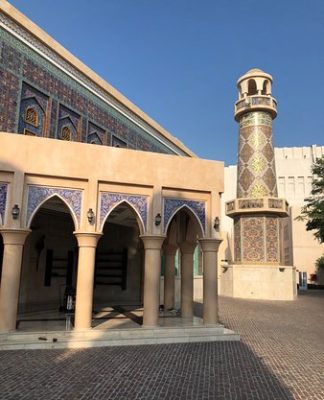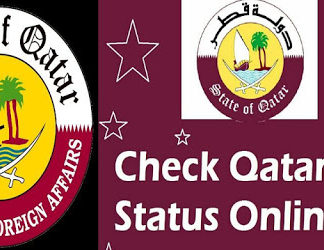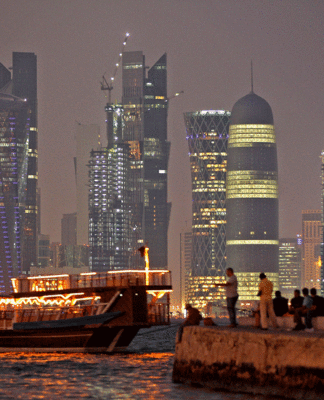Qatar History – A brief overview
The Al Thani family had lived in Qatar for 200 years. The 1916 treaty between the United Kingdom and Sheikh Abdullah was similar to those entered into by the British with other Persian Gulf principalities. Under it, the ruler agreed not to dispose of any of his territory except to the U.K. and not to enter into relationships with any other foreign government without British consent. In return, the British promised to protect Qatar from all aggression by sea and to lend their good offices in case of a land attack. A 1934 treaty granted more extensive British protection.
In 1935, a 75-year oil concession was granted to the Qatar Petroleum Company, a subsidiary of the Iraq Petroleum Company, which was owned by Anglo-Dutch, French, and U.S. interests. High-quality oil was discovered in 1940 at Dukhan, on the western side of the Qatari peninsula. However, the start of World War II delayed exploitation of Qatar’s oil resources, and oil exports did not begin until 1949.
During the 1950s and 1960s gradually increasing oil revenues brought prosperity, rapid immigration, substantial social progress, and the beginnings of Qatar’s modern history. When the U.K. announced a policy in 1968 (reaffirmed in March 1971) of ending the treaty relationships with the Persian Gulf sheikdoms, Qatar joined the other eight states then under British protection (the seven trucial sheikdoms—the present United Arab Emirates—and Bahrain) in a plan to form a union of Arab emirates. By mid-1971, as the termination date of the British treaty relationship (end of 1971) approached, the nine still had not agreed on terms of union. Accordingly, Qatar declared independence as a separate entity and became the fully independent State of Qatar on September 3, 1971.
In February 1972, the Heir Apparent, Sheikh Khalifa bin Hamad Al Thani, deposed his cousin, Ahmed bin Ali Al Thani, and assumed power. Key members of the Al Thani family supported this move, which took place without violence or signs of political unrest. On June 27, 1995, the Deputy Emir, Sheikh Hamad bin Khalifa, deposed his father Khalifa bin Hamad in a bloodless coup. An unsuccessful counter-coup was staged in 1996. The Emir and his father are now reconciled, though some supporters of the counter-coup remain in prison. The Emir announced his intention for Qatar to move toward democracy and has permitted a freer and more open press and municipal elections as a precursor to expected parliamentary elections. Qatari citizens approved a new constitution via public referendum in April 2003, which came into force in June 2005.
Human habitation of the Qatar Peninsula dates as far back as 50,000 years back, when small groups of Stone Age inhabitants built coastal encampments, settlements, and sites for working flint, according to archaeological evidences.
Other finds have included pottery from the Al Ubaid culture of Mesopotamia and northern Arabia (ca. 5000 B.C.), rock carvings, burial mounds, and a large town that dates from about 500 B.C. at Wusail, twenty kilometers north of Doha. The Qatar Peninsula was close enough to the Dilmun civilization (ca. 4000 to 2000 B.C.) in Bahrain to have felt its influence.
The peninsula was used almost continuously as rangeland for nomadic tribes from Najd and Al Hasa regions in Saudi Arabia, with seasonal encampments around sources of water. In addition, fishing and pearling settlements were established on those parts of the coast near a major well.
The Qatar Peninsula came under the sway of several great powers over the centuries. The Abbasid era (750-1258) saw the rise of several settlements, including Murwab.[citation needed] The Portuguese ruled from 1517 to 1538, when they lost to the Ottomans. In the 1732, the Al Bin Ali an off-Shoot of the Bani Utbah tribe migrated from Kuwait and returned to their original domicile Zubarah located on the northern – western coast of Qatar. After this migration, the Al Bin Ali were very close to the rich oyster banks. After the Persian Occupation of Basra in 1777 many merchants and families moved from Basra and Kuwait to Zubarah. After this movement, Zubarah became a thriving center of trade and pearling in the Persian Gulf region.
The battle of Zubarah took place in the year 1782 between the Al Bin Ali from the Bani Utbah Tribe and the Army of Nasr Al-Madhkur Ruler of Bahrain and Bushire.
In response to attacks on Zubarah by Nasr Al-Madhkur who ruled Bahrain and Bushehr in Persia, the Bani Utbah Al Bin Ali liberated Bahrainfrom the Persians in 1783.
After the Al Bin Ali Liberation of Bahrain in 1783, different Arab families and tribes mostly from Qatar moved to Bahrain to settle there. These families and tribes were Al-Ma’awdah, Al-Fadhil, Al-Mannai, Al-Noaimi, Al-Sulaiti, Al-Sadah, Al-Thawadi, and other families and tribes. Most of these tribes settled in Muharraq, the capital of Bahrain and the center of power at that time.
In the early nineteenth centuries, continuing bloody conflict involved not only the Al Khalifa, the Al Jalahima, and the Iranians but also the Omanis under Sayyid Said ibn Sultan Al Said, the nascent Wahhabis of Arabia, and the Ottomans. The period also saw the rise of Britishpower in the Persian Gulf as a result of their growing interests in India. Britain’s desire for secure passage for East India Company ships led it to impose its own order in the Persian Gulf. The General Maritime Treaty of 1820 between the East India Company and the sheikhs of the coastal area—which became known as the Trucial Coast because of the series of treaties between the sheikhs and the British—was a way of ensuring safe passage. The agreement acknowledged British authority in the Persian Gulf and sought to end piracy and the kidnapping of slaves. Bahrain also became a party to the treaty, and it was assumed by the British and the Bahrainis that Qatar, as a dependency, was also a party to it.

But when, as punishment for piracy, an East India Company vessel bombarded Doha in 1821, destroying the town and forcing hundreds to flee, the residents had no idea why they were being attacked.
In 1867, when a large Bahraini force sacked and looted Doha and Al Wakrah. This attack, and the Qatari counterattack, prompted the British political agent, Colonel Lewis Pelly, to impose a settlement in 1868. His mission to Bahrain and Qatar and the peace treaty that resulted were milestones in Qatar’s history because they implicitly recognized the distinctness of Qatar from Bahrain and explicitly acknowledged the position of Mohammed bin Thani, an important representative of the peninsula’s tribes.
Mohammed bin Thaniopposed Ottoman designs on Qatar, but his son, Jassim bin Mohammed, accepted Ottoman sovereignty in 1872. Although Jassim bin Mohammed privately complained of the Ottoman presence, he hoped that with Ottoman support he could dominate those sheikhs in other towns who opposed him and rebuff Bahrain’s claims on Az Zubarah. The question of Az Zubarah became moot in 1878, however, when Jassim bin Mohammed and his brother Ahmed bin Muhammed destroyed the town as punishment for the piracy of the Naim, a tribe that resided in the north of Qatar but was loyal to the sheikh of Bahrain. Moreover, Jassim bin Mohammed’s ambivalent relations with the Ottomans deteriorated to the point that in 1893 they sent a military force to Doha to arrest him, ostensibly over his refusal to permit an Ottoman customhouse in Doha. Fighting broke out, and Jassim bin Mohammed’s supporters drove out the Ottoman force.
The Ottomans officially renounced sovereignty over Qatar in 1913, and in 1916 the new ruler, Jassim bin Mohammed’s son, Abdullah bin Jassim Al Thani, signed a treaty with Britain bringing the peninsula into the trucial system. This meant that in exchange for Britain’s military protection from external threats, Qatar relinquished its autonomy in foreign affairs and other areas, such as the power to cede territory. The treaty also had provisions suppressing slavery, piracy, and gunrunning, but the British were not strict about enforcing those provisions.
Despite Qatar’s coming under British “protection,” Abdullah bin Jassim was far from secure: recalcitrant tribes refused to pay tribute; disgruntled family members intrigued against him; and he felt vulnerable to the designs of Bahrain, not to mention the Wahhabis. The al Thanis were merchant princes, reliant on trade and especially the pearl trade, and depended on others to do their fighting for them, primarily the Bini Hajar i.e. Al Hajiri/Hajeri who owed their allegiance to Ibn Saud, Emir of the Nejd and Al Hasa. Despite numerous requests by Abdullah bin Jassim — for strong military support, for weapons, and even for a loan — the British were reluctant to become involved in inland affairs and kept him at arm’s length. This changed in the 1930s, when competition (mainly between Britain and the United States) for oil concessions in the region intensified.

The scramble for oil raised the stakes in regional territorial disputes and highlighted the need to settle the national borders. The first move came in 1922 at a boundary conference in Uqair when the prospector Major Frank Holmes tried to include Qatar in an oil concession he was discussing with Ibn Saud. Sir Percy Cox, the British representative, saw through the ploy and drew a line on the map separating the Qatar Peninsula from the mainland.[3] The first oil survey took place in 1926 under the direction of a geologist of the Anglo-Persian Oil Company, George Martin Lees, but no oil was found. The oil issue raised its head again in 1933 after an oil strike in Bahrain—Lees had already noted that, in such an eventuality, Qatar should be investigated again. After lengthy negotiations between Anglo-Persian representatives and Sheikh Abdullah bin Jassim, on 17 May 1935 the sheikh put his signature to a concession agreement for a period of 75 years in return for 400,000 rupees on signature and 150,000 rupees per annum with royalties.As part of the agreement, Great Britain made more specific promises of assistance than in earlier treaties. Anglo-Persian transferred the concession to the IPC subsidiary Petroleum Development (Qatar) Ltd. in order to meet its obligations under the Red Line Agreement.
In 1936, Bahrain claimed rule over a group of islands, the largest of which is Hawar, on the west coast of Qatar because it had established a small military garrison there. Britain accepted the Bahraini claim over Abdullah bin Jassim’s objections, in large part because the Bahraini shaykh’s personal British adviser was able to frame Bahrain’s case in a legal manner familiar to British officials. The question of domain continued in the early 1990s. Triggered by a dispute involving the Naim, the Bahrainis once again laid claim to the deserted town of AzZubarah in 1937. Abdullah bin Jassim sent a large, heavily armed force and succeeded in defeating the Naim. The British political resident in Bahrain supported Qatar’s claim and warned Hamad ibn Isa Al Khalifa, the ruler of Bahrain, not to intervene militarily. Bitter and angry over the loss of Az Zubarah, Hamad ibn Isa imposed a crushing embargo on trade and travel to Qatar.
Drilling of the first oil well began at Jebel Dukhan in October 1938 and, over a year later, the well struck oil in the Upper Jurassic limestone which, unlike the Bahraimi strike, was similar to Saudi Arabia’s Dammam field discovered three years before. Production was halted between 1942 and 1947 because of World War II and its aftermath. The disruption of food supplies caused by the war prolonged a period of economic hardship in Qatar that had begun in the 1920s with the collapse of the pearl trade and had increased with the global depression of the early 1930s and the Bahraini embargo. As they had in previous times of privation, whole families and tribes moved to other parts of the Persian Gulf, leaving many Qatari villages deserted. Even Shaykh Abdullah bin Jassim went into debt and, in preparation for his retirement, groomed his favored second son, Hamad bin Abdullah Al Thani, to be his successor. Hamad bin Abdullah’s death in 1948, however, led to a succession crisis in which the main candidates were Abdullah bin Jassim’s eldest son, Ali bin Abdullah Al Thani, and Hamad bin Abdullah’s teenage son, Khalifa ibn Hamad Al Thani.
Oil exports and payments for offshore rights began in 1949 and marked a turning point in Qatar. Not only would oil revenues dramatically transform the economy and society, but they would also provide the focus for domestic disputes and foreign relations. This became frighteningly clear to Abdullah bin Jassim when several of his relatives threatened armed opposition if they did not receive increases in their allowances. Aged and anxious, Abdullah bin Jassim turned to the British, promised to abdicate, and agreed, among other things, to an official British presence in Qatar in exchange for recognition and support for Ali bin Abdullah as ruler in 1949.
The 1950s saw the cautious development of government structures and public services under British tutelage. Ali bin Abdullah was at first reluctant to share power, which had centered in his household, with an infant bureaucracy run and staffed mainly by outsiders. Ali bin Abdullah’s increasing financial difficulties and inability to control striking oil workers and obstreperous shaykhs, however, led him to succumb to British pressure. The first real budget was drawn up by a British adviser in 1953. By 1954 there were forty-two Qatari government employees.
A major impetus to the development of the British-run police force came in 1956 when about 2,000 demonstrators, who coalesced over issues such as Gamal Abdul Nasser’s pan-Arabism and opposition to Britain and to Shaykh Ali bin Abdullah’s retinue, marched through Doha. This and other demonstrations led Ali bin Abdullah to invest the police with his personal authority and support, a significant reversal of his previous reliance on his retainers and beduin fighters.
Public services developed haltingly during the 1950s. The first telephone exchange opened in 1953, the first desalination plant in 1954, and the first power plant in 1957. Also built in this period were a jetty, a customs warehouse, an airstrip, and a police headquarters. In the 1950s, 150 adult males of the Al Thani received outright grants from the government. Shaykhs also received land and government positions. This mollified them as long as oil revenues increased. When revenues declined in the late 1950s, however, Ali bin Abdullah could not handle the family pressures this engendered. That Shaykh Ali bin Abdullah spent extravagantly, owned a villa in Switzerland, and hunted in Pakistan fueled discontent, especially among those who were excluded from the regime’s largesse (non-Al Thani Qataris) and those who were not excluded but thought they deserved more (other branches of the Al Thani). Seniority and proximity to the shaykh determined the size of allowances.
Succumbing to family pressures and poor health, Ali bin Abdullah abdicated in 1960. But instead of handing power over to Khalifa ibn Hamad, who had been named heir apparent in 1948, he made his son, Ahmad ibn Ali, ruler. Nonetheless, Khalifa ibn Hamad, as heir apparent and deputy ruler, gained considerable power, in large part because Ahmad ibn Ali, as had his father, spent much time outside the country.
Largely under Khalifa ibn Hamad’s guiding hand, the infrastructure, foreign labor force, and bureaucracy continued to grow in the 1960s. There were even some early attempts at diversifying Qatar’s economic base, most notably with the establishment of a cement factory, a national fishing company, and small-scale agriculture.

The current Emir has announced his intention for Qatar to move towards democracy and has permitted a nominally free and open press and municipal elections. Economic, social, and democratic reforms have occurred in recent years. In 2003, a woman was appointed to the cabinet as minister of education.
Qatar and Bahrain have argued over who owns the Hawar Islands. In 2001, the International Court of Justice gave Bahrain sovereignty over Hawar Islands while giving Qatar sovereignty over smaller disputed islands and the Zubarah region on mainland Qatar.
Can be said About Qatar: In 2013 Sheikh Hamad Bin Khalifa stepped down from his position and gave the leadership to his son and heir Sheikh Tamim Bin Hamad which makes Sheikh Tamim the youngest Arab leader at the age of 33.
You can Read more ::

















